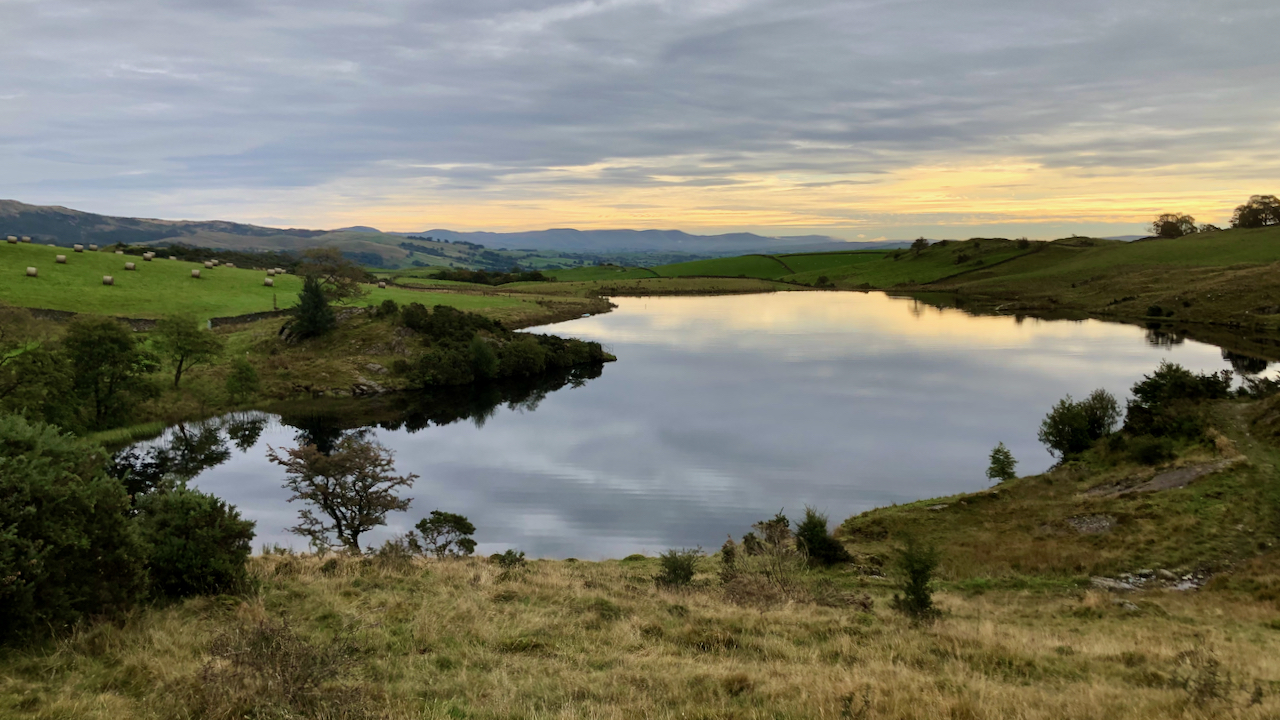A busy weekend near Staveley in the Kent valley, “gateway to the Lakes”.
Yesterday saw a return to Gurnal Dubs which visited in 2016 during the supervision of a DoE expedition.
Today Suart’s Reservoir which is on the south side of the valley in the parish of Nether Staveley. It is entirely on farmland with no public access so I feel privileged in being able to feature it today. It is unnamed on the Ordnance Survey map, but a local historian, the late Joe Scott, names it as “Suart’s Reservoir’1Scott, Joe. ‘A Lakeland Valley Through Time.’ Staveley and District History Society. 1995. Page 32. so that’s a good enough name for me. He gives a date of c. 1850, however I find that the Westmorland Gazette was advertising for “Wallers, Excavators & Puddlers” for “the making of a reservoir, near Staveley for the Messrs. Suart” on March 8th, 18542‘To Wallers, Excavators & Puddlers’. | Westmorland Gazette | Saturday 25 March 1854 | British Newspaper Archive’. 2022. Britishnewspaperarchive.co.uk <https://www.britishnewspaperarchive.co.uk/viewer/bl/0000399/18540325/071/0004> [accessed 25 September 2022]. So that could be one and the same.
There was an explosion of reservoir construction in the Kent valley at this time due to the numerous mills needing a reliable flow of water.
There were some 15 mills on the river Kent and its tributaries, the Sprint and the Mint, in 1844, and an Act of Parliament was proposed to build 8 reservoirs3‘Proposed Embankment of the River Kent. | Kendal Mercury | Saturday 23 November 1844 | British Newspaper Archive’. 2022. Britishnewspaperarchive.co.uk <https://www.britishnewspaperarchive.co.uk/viewer/bl/0000430/18441123/016/0003> [accessed 25 September 2022]. This proposal was not universally accepted, and was described as a ‘wild scheme’ by one reader of the Westmorland Gazette4‘The Reservoirs. | Westmorland Gazette | Saturday 14 December 1844 | British Newspaper Archive’. 2022. Britishnewspaperarchive.co.uk <https://www.britishnewspaperarchive.co.uk/viewer/bl/0000399/18441214/016/0003> [accessed 25 September 2022].
Traditionally the majority were fulling mills but in 1784, a cotton mill was built with a massive 16 foot head of water following the success of these factories in Derbyshire and Lancashire. In 1819 a canal was built linking Kendal to Lancashire which encouraged mills to be built for wood turning of bobbins. By 1851, 193 local people were employed in the bobbin trade compared with 25 in textiles5Scott. Page 32..
Bobbin turning was very dangerous work, although relatively well paid. Conditions were unhealthy with long hours and employing children as young as 8.
In 1865, there was a Parliamentary Commission into Children’s Employment. Evidence was obtained from the bobbin mills of Staveley6Scott. Page 33.:
Mr J Marson, manager of Chadwick’s Mill, later the Staveley Wood Turning Company:
“This is about the largest bobbin mill in the neighbourhood. There are 31 boys, the two youngest 8 years old, and about 50 men. When overtime is made perhaps they get up an hour a day by taking half an hour for tea and working till 7.30pm. The machinery always stops at meals. The work is dusty, but not, I think, unhealthy.”
Dr Thomas Dobson, of Windermere
“I am confident that the mortality from consumption would be found alarmingly high, attributable to the young and tender age of entering the mill, long hours, exclusion from sunlight and fresh air, dusty nature of work, mode of living, want of outdoor exercise, and in some instances to the badly lighted and ventilated mills.”
William Philipson, Bobbin Turner
“I have worked here 10 years. I was just about 8 when I came. Our hours are from 6am. to 6pm. with half an hour for breakfast and the same for dinner. We have sometimes worked longer, till 8pm. for a week together.
One time a few of us worked all night as well as the day. They wanted to get some bobbins off. Don’t like the work, it is so dusty, and stuffs you up so. Have been hurt often. One time I split through the part between my thumb and hand. The bit that you bore with flew out and struck me. I was about 10.”
But I digress. Suart’s Reservoir.
I haven’t been able to find out exactly why the reservoir was built. If indeed it was all part of the management of the River Kent for the benefit of the mill owners. Fairbank Farm, on which land the reservoir is located, is the site of a medieval water powered mill so prior to the 1850 date there may have been a pre-existing reservoir on a smaller scale7‘Heritage Gateway – Results’. 2012. Heritagegateway.org.uk <https://www.heritagegateway.org.uk/Gateway/Results_Single.aspx?uid=2889181&resourceID=801> [accessed 25 September 2022].
- 1Scott, Joe. ‘A Lakeland Valley Through Time.’ Staveley and District History Society. 1995. Page 32.
- 2‘To Wallers, Excavators & Puddlers’. | Westmorland Gazette | Saturday 25 March 1854 | British Newspaper Archive’. 2022. Britishnewspaperarchive.co.uk <https://www.britishnewspaperarchive.co.uk/viewer/bl/0000399/18540325/071/0004> [accessed 25 September 2022]
- 3‘Proposed Embankment of the River Kent. | Kendal Mercury | Saturday 23 November 1844 | British Newspaper Archive’. 2022. Britishnewspaperarchive.co.uk <https://www.britishnewspaperarchive.co.uk/viewer/bl/0000430/18441123/016/0003> [accessed 25 September 2022]
- 4‘The Reservoirs. | Westmorland Gazette | Saturday 14 December 1844 | British Newspaper Archive’. 2022. Britishnewspaperarchive.co.uk <https://www.britishnewspaperarchive.co.uk/viewer/bl/0000399/18441214/016/0003> [accessed 25 September 2022]
- 5Scott. Page 32.
- 6Scott. Page 33.
- 7‘Heritage Gateway – Results’. 2012. Heritagegateway.org.uk <https://www.heritagegateway.org.uk/Gateway/Results_Single.aspx?uid=2889181&resourceID=801> [accessed 25 September 2022]

Leave a Reply